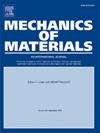A Physics-Informed Neural Network model for combined high and low cycle fatigue life prediction
IF 3.4
3区 材料科学
Q2 MATERIALS SCIENCE, MULTIDISCIPLINARY
引用次数: 0
Abstract
Turbine blades in aeroengines operate under combined high and low cycle fatigue (CCF) loads. Such a complex loading type makes it challenging to accurately assess CCF life. In response, we introduce an innovative framework that integrates physical models with neural networks (NN), known as a Physics-Informed Neural Network (PINN), to boost the accuracy of CCF life prediction. Life data from 11 types of alloys and full-scale turbine blades, with a sample size of 99, are utilized to train and validate the PINN-based model. The results show that, compared to conventional physics-informed models, the PINN provides significantly higher accuracy in predicting CCF life. Based on a substantial amount of experimental data, all PINN predictions fall within 3 times the dispersion bands, whereas the predictions from conventional physical models fall out of 10 times the dispersion bands. We also thoroughly investigate the key factors influencing the prediction accuracy of the PINN model, including the types of physical models and the machine learning algorithms employed. The present study provides a precise and efficient tool for predicting the CCF life of turbine blades.
高、低周疲劳寿命联合预测的物理信息神经网络模型
航空发动机的涡轮叶片在高、低周疲劳(CCF)载荷下工作。如此复杂的载荷类型使得准确评估CCF寿命具有挑战性。作为回应,我们引入了一个创新的框架,将物理模型与神经网络(NN)相结合,称为物理信息神经网络(PINN),以提高CCF寿命预测的准确性。来自11种合金和全尺寸涡轮叶片的寿命数据,样本量为99,用于训练和验证基于ppin的模型。结果表明,与传统的物理信息模型相比,PINN在预测CCF寿命方面提供了更高的准确性。基于大量的实验数据,所有的PINN预测都落在色散带的3倍以内,而传统物理模型的预测落在色散带的10倍以内。我们还深入研究了影响PINN模型预测精度的关键因素,包括物理模型的类型和所采用的机器学习算法。本研究为涡轮叶片CCF寿命的预测提供了一种精确、有效的工具。
本文章由计算机程序翻译,如有差异,请以英文原文为准。
求助全文
约1分钟内获得全文
求助全文
来源期刊

Mechanics of Materials
工程技术-材料科学:综合
CiteScore
7.60
自引率
5.10%
发文量
243
审稿时长
46 days
期刊介绍:
Mechanics of Materials is a forum for original scientific research on the flow, fracture, and general constitutive behavior of geophysical, geotechnical and technological materials, with balanced coverage of advanced technological and natural materials, with balanced coverage of theoretical, experimental, and field investigations. Of special concern are macroscopic predictions based on microscopic models, identification of microscopic structures from limited overall macroscopic data, experimental and field results that lead to fundamental understanding of the behavior of materials, and coordinated experimental and analytical investigations that culminate in theories with predictive quality.
 求助内容:
求助内容: 应助结果提醒方式:
应助结果提醒方式:


